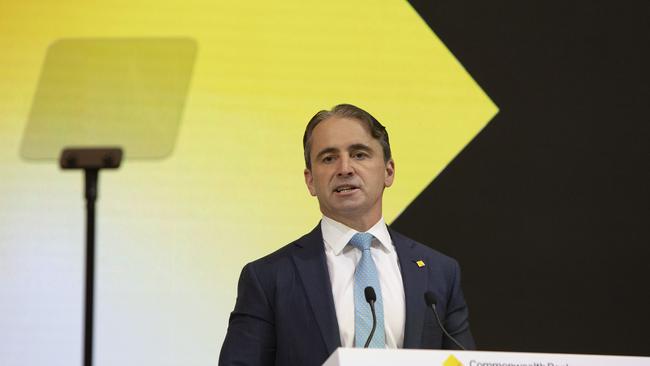CBA books flat cash earnings of $2.5bn as RBA rate cuts could be delayed
CEO Matt Comyn says global geopolitical tensions are creating uncertainty as higher rates continue to weigh on consumer demand after Australia’s biggest bank reported flat quarterly cash earnings of $2.5bn.

Business
Don't miss out on the headlines from Business. Followed categories will be added to My News.
Official rates may stay higher for longer, with the outlook “finely balanced” following the US election and as inflation comes down at a slower pace, Commonwealth Bank boss Matt Comyn has cautioned.
Speaking to The Australian after revealing a $2.5bn cash profit for the bank’s first quarter, Mr Comyn said rate expectations globally had adjusted following the US election, with the prospect of higher-for-longer US rates potentially feeding through to a similar fate for Australia.
“I think it’s very finely balanced. There’s a couple of data points, particularly the December CPI … and small changes in that will obviously be a very important driver (for rates),” Mr Comyn said.
“It is currently our view (that the RBA will cut in early 2025) but I think it’s very finely balanced about whether it is February or later in the year.”
CBA was the last of the major lenders to push back its rate cut expectations to 2025, only recently changing its call from a December cut.
But with a Trump election win, and the prospect of US tax cuts and widespread tariffs across US imports, economists and market watchers are bracing for rates to stay higher, even if the first cut comes early next year.
Other major bank CEOs, including National Australia Bank’s Andrew Irvine and ANZ’s Shayne Elliott, were last week similarly cautious on the rate outlook following the US election result, with both warning of higher-for-longer rates if the US president-elect follows through on his promises to impose widespread tariffs on imports.
Mr Comyn on Wednesday said global geopolitical tensions were creating uncertainty at a time when moderation in inflation was slowing.
“Rates have slightly adjusted globally, but particularly in the US following the US election. There’s a lot of focus on exactly what policies will be implemented, will there be changes in the US dollar, what the fiscal impact will be,” Mr Comyn said.
I think, broadly, rates (could be) slightly higher for longer, certainly in the US, and that may have an impact in Australia.
“Growth in the Australian economy remains slow, as higher rates continue to weigh on consumer demand and bring inflation back to the target range,” Mr Comyn cautioned.
While consumers are still under pressure from the higher cost of living, this did not translate to higher arrears in the quarter.
Personal loan and credit card arrears over the three months to September 30 actually ticked down — there is an element of seasonality here — while home loan arrears remained stable.

While some of the other major lenders have in recent days declared peak consumer stress had passed, Mr Comyn gave no such assurance.
“We are trying to support and proactively help all of our customers. We recognise that many households continue to feel the pressures from cost of living. The short term direction is slightly positive, but we continue to watch that very carefully,” he said.
“Overall, where unemployment is, I don’t think there’s anything in the near term that gives us particular cause for concern. A stabilisation, or perhaps a gradual deterioration, into the end of this calendar year and the new year would be our base case,” he said.
The bank expects household incomes will rebound in 2025 as inflation comes down.
“And of course, at some point in the year we’ll start to see rates easing, which will help households in particular.”
CBA’s quarterly cash earnings, up 5 per cent on the quarterly average for the second half of 2024, followed improved momentum in volume growth across home lending and household deposits. The cash profit was in line with analyst expectations.
The bank grew business lending and household deposits, adding $2.1bn to its business lending book and $14.9bn in deposits. Home lending grew $8.6bn, at 1.3 times system.
The above-system growth in home lending comes after CBA’s market share went backward in 2024 as the bank prioritised profits over volume.
Operating income was up 3.5 per cent, while expenses lifted 3 per cent due to wage inflation and increased investment spend.
The bank booked loan impairment expenses of $160m in the period, with collective provisions slightly higher, but said portfolio credit quality remained sound.
Home lending arrears remained stable at 0.65 per cent, as troublesome and impaired assets rose to $8.8bn.
Total credit provisions were $6.2bn, with an increase in collective provisions to $5.5bn, and individual provisions flat.
UBS analyst John Storey said trading update showed a number of positive trends most
notably around an improving revenue outlook, with net interest margin up around 3 basis points quarter-on-quarter, based on UBS estimates.
“Positive jaws, with revenue up 3.1 per cent quarter on quarter and costs down 0.2 per cent, resulted in pre-provision operating profit being up 5.9 per cent quarter on quarter,” Mr Storey told clients.
“Asset quality trends appear benign with credit impairments to gross loans and advances of 7 basis points and non-performing loans at 63 basis points, flat quarter on quarter,” he said.
Franchise momentum across the consumer and business banking divisions was strong, Mr Storey added.
CBA shares closed down 0.4 per cent at $149.62, after paring early losses. They had hit a record high above $150-a-share earlier this week.
More Coverage
Originally published as CBA books flat cash earnings of $2.5bn as RBA rate cuts could be delayed





